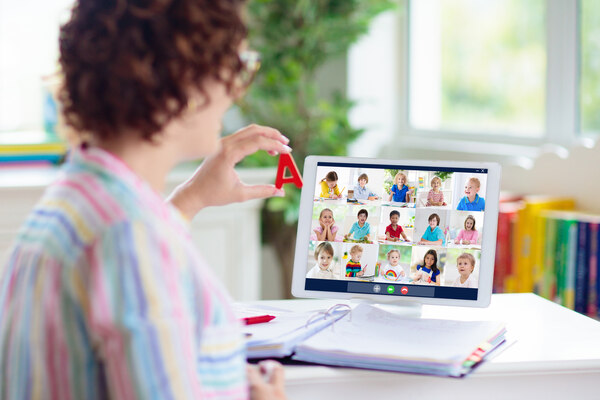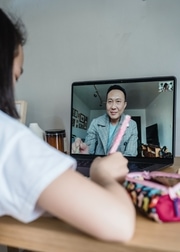Pros and Cons of Online Jobs in Teaching
Online jobs in teaching are now more popular than ever, thanks to the world’s shift to working from home and e-learning. Plus, the tempting idea of becoming a digital nomad and the flexibility it allows make online teaching no longer just a lucrative side-hustle but a possible primary source of income.
Due to its wide availability, many people who may not have considered teaching as a profession in the past are now looking into online jobs in teaching. However, like any regular job that has its perks, it also has some drawbacks.
Before we begin, here are some resources to help you find online teaching jobs.
Remote Online Teaching Jobs
- 10 Companies That Hire for Online Teaching Jobs
- Colleges and Education Companies That Hire for Online Professor Jobs
- What Are Online Tutoring Jobs? How to Become a Tutor Online
Now, to help you decide if online jobs in teaching is for you, we’ll discuss both the pros and the cons.
The Perks of Teaching Online
1. Work from anywhere
One of the best parts of any online job is that you aren’t anchored to a desk in a fixed location. As long as you have a reliable device and internet connection, you can work from wherever you are in the world.
This flexibility is especially beneficial for parents with young children or those who like to travel — no need to worry about limited leaves!
2. Meet and connect with people from all over the world
If you decide to teach English or any other language, your students will likely be from other countries. Online teaching companies will connect you with students from countries in Asia, South America, Europe, and other parts of the world.
The opportunity to meet people from all over the globe from the comforts of your home is a fantastic experience that not many jobs can offer. Not only do you get to teach someone a new skill, but you are also able to learn about new cultures.
3. Minimal requirements
Unlike in-person teaching jobs in schools, most online teaching companies don’t require a degree in education or a teaching license to apply. While most will require some credentials, such as the Teaching English as a Second Language (TEFL) certificate, this is something that you can apply for online.
Some companies don’t even require prior experience or any certifications. As long as you’re proficient in the language or subject you’d like to teach, you’re qualified to apply.
4. Structure and lessons plans are usually provided
The hardest part of traditional teaching jobs is the task of preparing lesson plans and syllabi for your students. Thankfully, most online teaching companies provide all the material you need. This is especially helpful because your students will have varying levels of competency, and having to tailor lesson plans for each individual can get taxing.
5. Class sizes are controlled
Handling more than a handful of kids can get highly stressful, especially in an online setting. You don’t have to worry about classroom management as most online teaching classes are conducted in small groups or are one-on-one. For any teacher who’s tried to teach in a traditional crowded classroom, this is a dream come true.
In a small group or one-on-one setting, each student can get the attention they need, and you don’t have to worry about anyone falling behind. You can structure your lessons based on what your students are interested in to ensure they are always engaged.
The Cons of Teaching Online
No doubt there are plenty of positives to finding an online job in teaching. Flexibility creates a unique lifestyle that most people envy, especially if they don’t like their current job or profession. Finding an online job as a teacher can also a way to bridge the gap between contracts, even for a short period of time. We’ve explored the pros, not let’s look at the cons.
Teaching online is not for everyone. You may be in search regular teaching job or teaching assistant jobs that are available in your current location or a place you would be willing to move to. If you are currently satisfied with your teaching job in the classroom, you’ll want to explore the downsides of teaching online before making the switch.
1. Technical difficulties are inevitable
No internet connection will ever be 100% stable. Not to mention, you can never really predict when your gadgets will decide to act up.
Having an online teaching job will mean you always have to have backup plans. Do you have a portable internet device in handy?
You also can’t scrimp on gadgets because they will affect your ability to do your job competently. Investing in a fast internet provider, a reliable laptop or computer, good-quality headsets, and microphones are non-negotiable.
2 Less Stability and security
It might sound wonderful to have the freedom to choose your schedule and workload, but you also lose the comforts of having a stable salary in your desire to earn money as a teacher online. Even if you have regular students, most of them are on a pay-per-class basis, which means that they can decide to drop your class at any time.
As an online teacher, you don’t get benefits like paid leaves, retirement, or insurance, so you have to work on getting those all on your own.
3. There’s still nothing like in-person interactions
Working remotely and being stuck at home all day can get lonely — no matter how much you like it. In fact, research shows that full-time remote work has increased loneliness by 67%. If you’re not mindful of how much time you spend working alone and indoors, loneliness can creep up on you unexpectedly. Knowing this, you need to make a conscious effort to meet other people and find time for in-person conversations.
Another important factor of work at home alone is the potential loss of effective communication between parents and teachers, which is enough of a challenge in a traditional teaching role.
4. Not much opportunity for career growth
Online jobs in teaching may get you a decent paycheck but unlike full-time office jobs that offer you a clear career path and opportunity for promotions, you can’t expect the same while teaching online. At most, you can get a pay-per-hour increase, but there’s a cap to that.
If you’re someone who is looking to advance in your profession, online teaching might not be for you.
5. Too much screen time is never good
As it is, you probably already spend hours scrolling through the internet. Teaching online will only add to your hours spent staring at a computer screen. Too much screentime could lead to eye problems, back and neck strains, and even sleep deprivation.
Is Online Teaching For You?

Online teaching is an exciting opportunity that’s become widely available. If teaching is your passion and you prefer the autonomy and flexibility of working from home, then you should definitely consider applying online. However, before you go all in, it’s important to be aware of its downsides.
If you currently have a teaching job, including SEN teaching assistant jobs, you may not have to choose between your traditional teaching position and an online one. Depending on your schedule, there may be opportunities to supplement your income if time allows for you to have an online teaching job on the side. This can often happen when teaching ESL to students in a different time zone.
Like any job — remote or in-person — it’s not going to be perfect. The best thing about online teaching? Most companies won’t require contracts. You can try a few classes to get a feel of the experience. If you want to balance it with other jobs, you can teach part-time. If you decide it’s not for you, you can search for something new in no time at all.
Remote Work in Education
If you are not a teacher but an educator with administrative skills, it’s also possible to find remote employment for schools and school boards seeking flexible remote workers. These types of teacher related positions come with benefits, such as the ability to work part time with no commute costs and other expenses related to traditional work in an office. Find Organizations That Hire for Remote Higher Ed Jobs.









